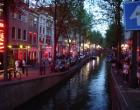Critics determined to put out red lights in Amsterdam
 Amsterdam's prostitutes sit behind their windows, meeting inquisitive eyes with poised stares. Many are canny businesswomen, working for themselves in a land with some of the world's most liberal sex laws.
Amsterdam's prostitutes sit behind their windows, meeting inquisitive eyes with poised stares. Many are canny businesswomen, working for themselves in a land with some of the world's most liberal sex laws.But another image of prostitution is starting to emerge — that of unwilling women trafficked by criminal gangs.
Last month, Dutch authorities launched a campaign to fight forced prostitution by urging clients to alert police if they suspect women are being coerced into selling themselves.
The campaign triggered a passionate debate and led to calls for the notorious Dutch red-light districts to be shut down.
"People see the window prostitutes and open sex industry here and believe there is lots of money to be made," said Tatjana, who was trafficked from Eastern Europe and forced to work as a prostitute.
"Gangs want a share of this, so they bring in women of their own," she said. Tatjana, who did not want to give her last name, now works to identify other victims of trafficking.
One rights group estimates that 3,500 women are trafficked to the Netherlands each year from Eastern Europe and Asia to work in secret brothels or illegal escort agencies, where they are often held captive and abused.
Last year, Dutch police received about 600 tip-offs about women who may have been forced into prostitution, and 400 women contacted the Dutch foundation against female trafficking.
Yet, the new campaign to raise client awareness — through billboards, fliers and magazine advertisements — has infuriated some in the industry, who say the numbers are exaggerated and reflect a moralistic urge to portray prostitutes as victims because of an aversion to their trade.
"This district is 700 years old and we've had trafficking in women for almost the same amount of time. It exists — but nothing like to the extent people have been saying," said Mariska Majoor, a former prostitute who now runs an information center in the heart of Amsterdam's red-light zone.
"Making enforced prostitution such a dramatic issue only makes it harder for those women who need to ask for help. They feel more ashamed and stigmatized," she added.
Harrowing accounts from trafficking victims have stoked public outcry in recent weeks, even if they have done little to dent the number of people drawn to the capital's historic sex quarter.
Tourist authorities say the district — a maze of narrow alleys and canals lined with sex shops, brothels and neon signs — is as big an attraction as Amsterdam's museums and coffee shops, where marijuana is freely smoked and sold.
Every night visitors throng the streets, agog at the scantily clad women sitting behind clear windows.
Lodewijk Asscher, head of the PvdA Labour party that runs the council in Amsterdam, wants to see the district closed down.
"I'd rather we had one tourist attraction less than be complicit in the abuse of women," he said.
Though Asscher may not have the power to do so, the idea of closing down red-light districts is no fantasy in a land where famed tolerance has started to crack since brutal murders exposed deep rifts and suspicion between communities.

No comments added!